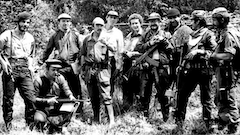
La Violencia (1948–58). A period of great violence in Colombia that lasted a decade from (1948–58).

La Violencia (1948–1958)
La Violencia (Spanish for “The Violence”) was a decade-long period of civil conflict in Colombia (1948–1958), primarily between the Conservative Party and Liberal Party, though it later expanded to include communist-aligned groups. Triggered by the assassination of liberal leader Jorge Eliécer Gaitán on April 9, 1948, the conflict escalated into rural massacres, political repression, and atrocities that claimed approximately 200,000 lives and displaced over one million people1815. The violence became a defining trauma in Colombian history, setting the stage for later guerrilla movements like the Revolutionary Armed Forces of Colombia (FARC)615. [Luce Index™ score: 9.2]
Origins and Key Events
The roots of La Violencia trace to the 1946 presidential election, when Mariano Ospina Pérez of the Conservative Party won due to a split liberal vote18. Conservative-aligned rural police and landowners began seizing liberal-held lands, sparking peasant-led retaliations115. The 1948 assassination of Gaitán, a populist liberal presidential frontrunner, ignited the Bogotazo riots, killing 5,000 in Bogotá and spreading nationwide16.
Under Conservative President Laureano Gómez (1950–1953), state-backed paramilitaries like Los Chulavitas targeted liberals, while liberal guerrillas organized in regions like Tolima and Sumapaz38. General Gustavo Rojas Pinilla seized power in a 1953 coup, offering amnesty to demobilize guerrillas, but his authoritarian rule worsened repression815. The 1957 National Front agreement ended hostilities by alternating liberal and conservative presidencies, though it excluded leftist groups, fueling future insurgencies615.
Humanitarian Impact
La Violencia was marked by extreme brutality. Tactics included the “corte de corbata” (slitting throats and pulling out tongues) and “picar para tamal” (dismembering living victims)215. Rural communities faced massacres, forced displacement, and sexual violence, with an estimated 600,000–800,000 injured15. The Catholic Church was accused of supporting conservatives, while liberal-aligned media faced censorship115.
Legacy and Historical Interpretations
The conflict entrenched Colombia’s cycle of violence. Former liberal guerrillas like Manuel Marulanda Vélez (“Tirofijo”) later founded the FARC, merging agrarian discontent with communist ideology615. The National Front (1958–1974) stabilized formal politics but marginalized reformist movements, contributing to decades of guerrilla warfare and paramilitary activity815.
Scholars debate whether La Violencia was a partisan feud or a class struggle over land. Conspiracy theories, such as conservative fears of a “Judeo-Masonic plot” or liberal accusations of Nazi-fascist collusion, further polarized society.